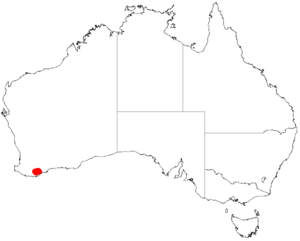Veronica's wattle facts for kids
Quick facts for kids Veronica's wattle |
|
|---|---|
| Conservation status | |
| Scientific classification | |
| Genus: |
Acacia
|
| Species: |
veronica
|
 |
|
| Occurrence data from AVH | |
Acacia veronica, commonly known as Veronica's wattle, is a special type of shrub or small tree. It belongs to the Acacia family, which is famous for its many different kinds of wattles. This plant is found only in a small area of southwestern Australia. This means it is endemic to that region, growing naturally nowhere else in the world.
Contents
What Veronica's Wattle Looks Like
This plant can grow from about 1.5 to 10 metres (5 to 33 ft) tall. Its branches are smooth and have fine ribs. When they are young, they can be a bit sticky like resin.
Instead of regular leaves, Veronica's wattle has phyllodes. These are flattened leaf stems that act like leaves. They are thin, leathery, and stay green all year. Each phyllode is usually straight or slightly curved. They are about 9 to 15 cm (3.5 to 5.9 in) long and 3 to 8 mm (0.12 to 0.31 in) wide. Each one has two or three main veins, with the middle one being the clearest.
Flowers and Seed Pods
Veronica's wattle blooms from March to September. It produces lovely white or cream-colored flowers. These flowers grow in pairs on short stalks called racemes. Each flower cluster is a round ball, about 7 to 12 mm (0.28 to 0.47 in) across. Each ball contains 24 to 27 small, white to cream-colored flowers.
After the flowers, seed pods grow. These pods are thin and can be up to 11 cm (4.3 in) long and 5 to 6 mm (0.20 to 0.24 in) wide. Inside, you'll find shiny, dark brown seeds. The seeds are about 6 mm (0.24 in) long and have a small, white, fleshy part called an aril attached to them.
How Scientists Named Veronica's Wattle
Scientists use a system called taxonomy to name and group living things. Acacia veronica was first officially described by a botanist named Bruce Maslin in 1989. He wrote about it in a scientific journal called Nuytsia.
Later, in 2003, another botanist named Leslie Pedley reclassified it. He gave it a different scientific name, Racosperma veronicae. However, in 2006, it was moved back to the Acacia group. Scientists think Veronica's wattle is related to Acacia spongolitica. It also looks a bit like Acacia cyclops.
Where Veronica's Wattle Grows
Veronica's wattle is native to the Great Southern region of Western Australia. It likes to grow in sheltered spots, often near mountain tops or in valleys along creeks and streams.
You can find this plant mainly inside the Stirling Range National Park. It grows in woodlands and forests alongside other trees like Eucalyptus marginata and Corymbia calophylla, or Eucalyptus wandoo.


